Academic Success for Undergrad and Graduate EAL Students: A Report
VerifiedAdded on 2022/10/02
|16
|3983
|12
Report
AI Summary
This report investigates the academic success of undergraduate and graduate students, particularly focusing on English as an Additional Language (EAL) learners. The study, conducted across 21 universities in the United States and Canada, involved 155 undergraduates, 215 graduate staff, 103 college students, and 242 graduate students. The research aims to interpret hypothetical structures in reading, writing, speaking, and listening, as developed by EAL Framework Teams. The report analyzes assignment structures and outcomes, emphasizing the importance of language testing, task analysis, and academic communication skills. Findings highlight the significance of these assignments for successful coursework completion at both levels, with a focus on narrative understanding, vocabulary, and cohesive linguistic structures. The study validates the use of these assignments in test specifications and evaluation measures across various disciplines, providing valuable insights for educators and students.
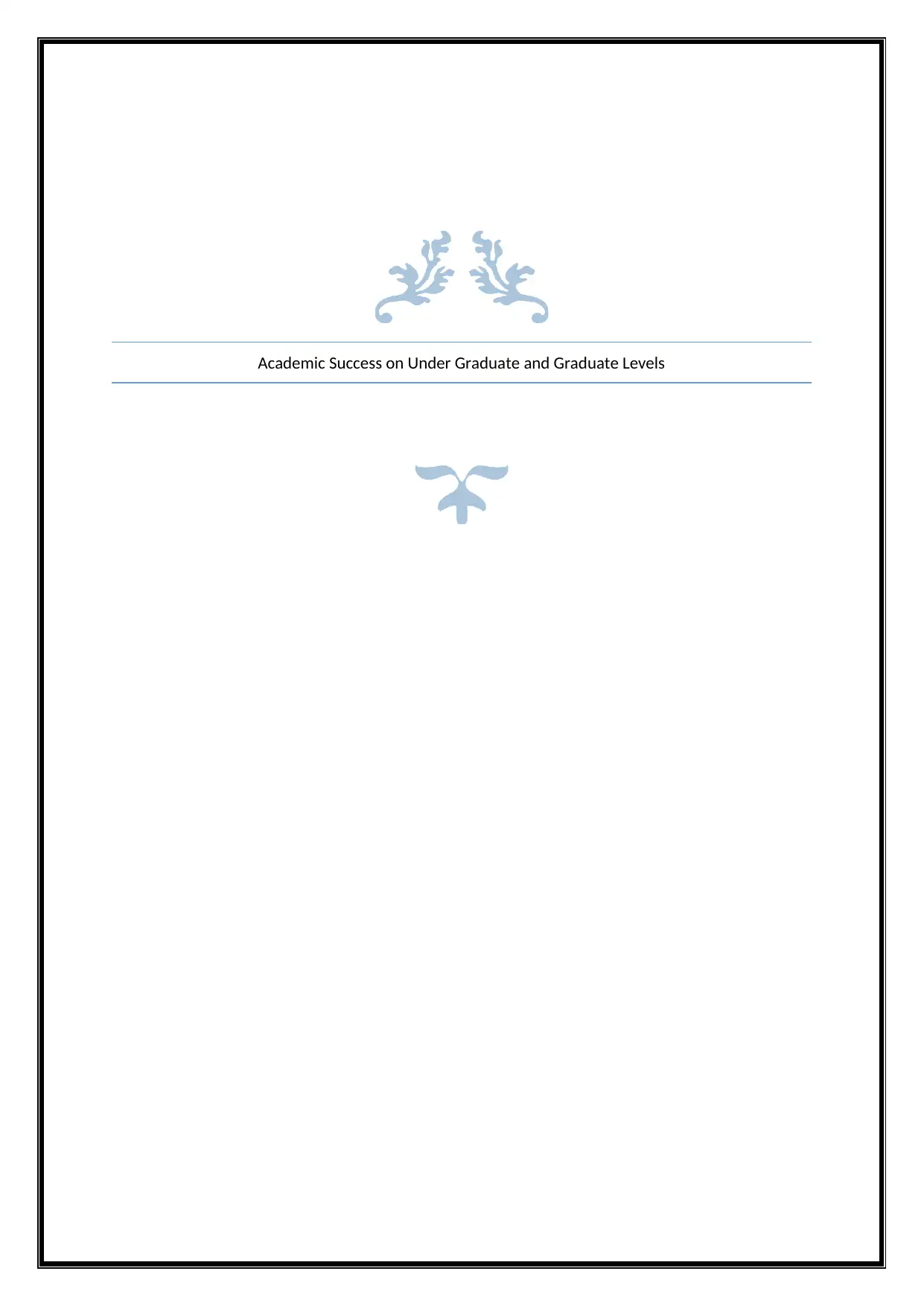
Academic Success on Under Graduate and Graduate Levels
Paraphrase This Document
Need a fresh take? Get an instant paraphrase of this document with our AI Paraphraser
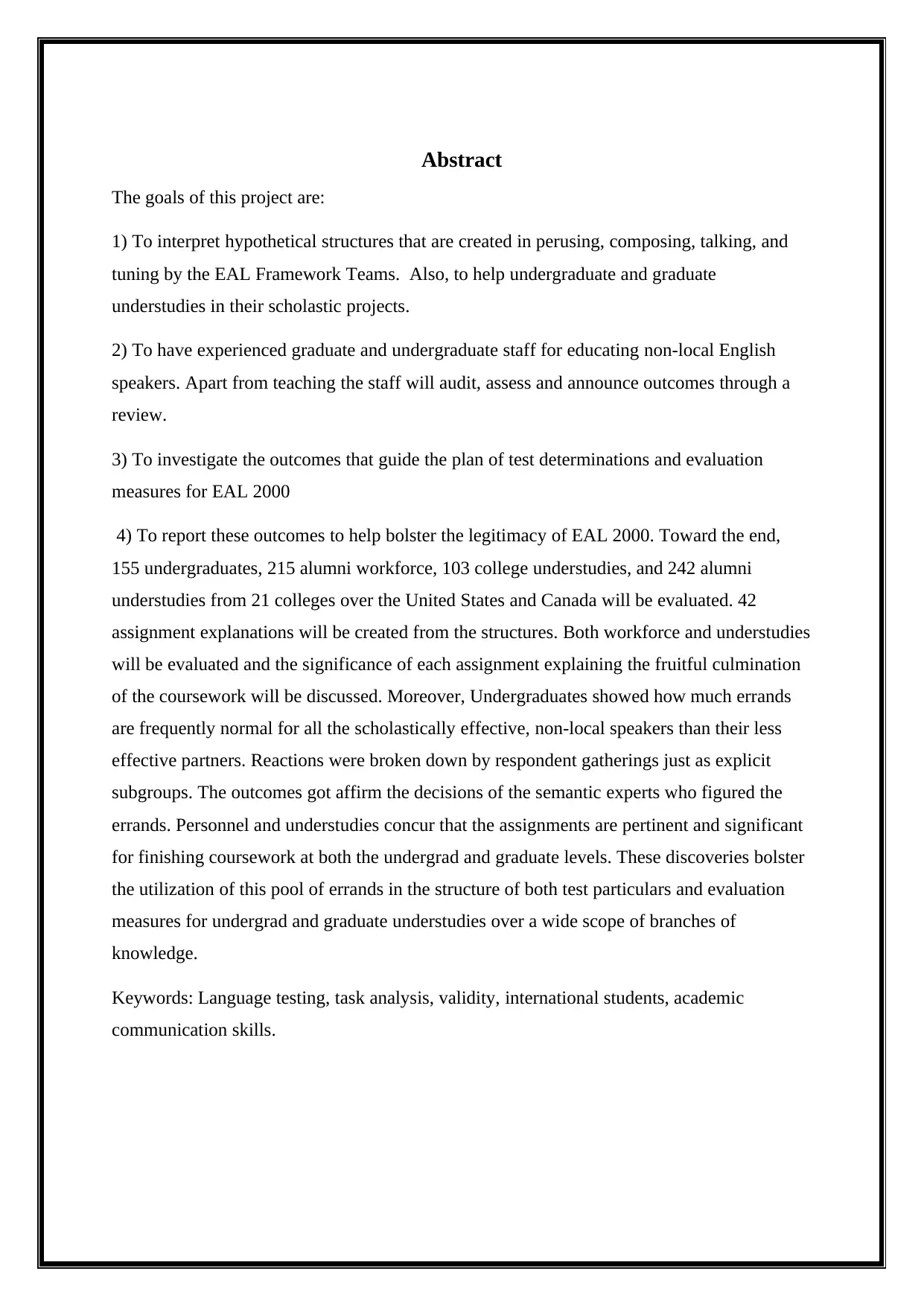
Abstract
The goals of this project are:
1) To interpret hypothetical structures that are created in perusing, composing, talking, and
tuning by the EAL Framework Teams. Also, to help undergraduate and graduate
understudies in their scholastic projects.
2) To have experienced graduate and undergraduate staff for educating non-local English
speakers. Apart from teaching the staff will audit, assess and announce outcomes through a
review.
3) To investigate the outcomes that guide the plan of test determinations and evaluation
measures for EAL 2000
4) To report these outcomes to help bolster the legitimacy of EAL 2000. Toward the end,
155 undergraduates, 215 alumni workforce, 103 college understudies, and 242 alumni
understudies from 21 colleges over the United States and Canada will be evaluated. 42
assignment explanations will be created from the structures. Both workforce and understudies
will be evaluated and the significance of each assignment explaining the fruitful culmination
of the coursework will be discussed. Moreover, Undergraduates showed how much errands
are frequently normal for all the scholastically effective, non-local speakers than their less
effective partners. Reactions were broken down by respondent gatherings just as explicit
subgroups. The outcomes got affirm the decisions of the semantic experts who figured the
errands. Personnel and understudies concur that the assignments are pertinent and significant
for finishing coursework at both the undergrad and graduate levels. These discoveries bolster
the utilization of this pool of errands in the structure of both test particulars and evaluation
measures for undergrad and graduate understudies over a wide scope of branches of
knowledge.
Keywords: Language testing, task analysis, validity, international students, academic
communication skills.
The goals of this project are:
1) To interpret hypothetical structures that are created in perusing, composing, talking, and
tuning by the EAL Framework Teams. Also, to help undergraduate and graduate
understudies in their scholastic projects.
2) To have experienced graduate and undergraduate staff for educating non-local English
speakers. Apart from teaching the staff will audit, assess and announce outcomes through a
review.
3) To investigate the outcomes that guide the plan of test determinations and evaluation
measures for EAL 2000
4) To report these outcomes to help bolster the legitimacy of EAL 2000. Toward the end,
155 undergraduates, 215 alumni workforce, 103 college understudies, and 242 alumni
understudies from 21 colleges over the United States and Canada will be evaluated. 42
assignment explanations will be created from the structures. Both workforce and understudies
will be evaluated and the significance of each assignment explaining the fruitful culmination
of the coursework will be discussed. Moreover, Undergraduates showed how much errands
are frequently normal for all the scholastically effective, non-local speakers than their less
effective partners. Reactions were broken down by respondent gatherings just as explicit
subgroups. The outcomes got affirm the decisions of the semantic experts who figured the
errands. Personnel and understudies concur that the assignments are pertinent and significant
for finishing coursework at both the undergrad and graduate levels. These discoveries bolster
the utilization of this pool of errands in the structure of both test particulars and evaluation
measures for undergrad and graduate understudies over a wide scope of branches of
knowledge.
Keywords: Language testing, task analysis, validity, international students, academic
communication skills.
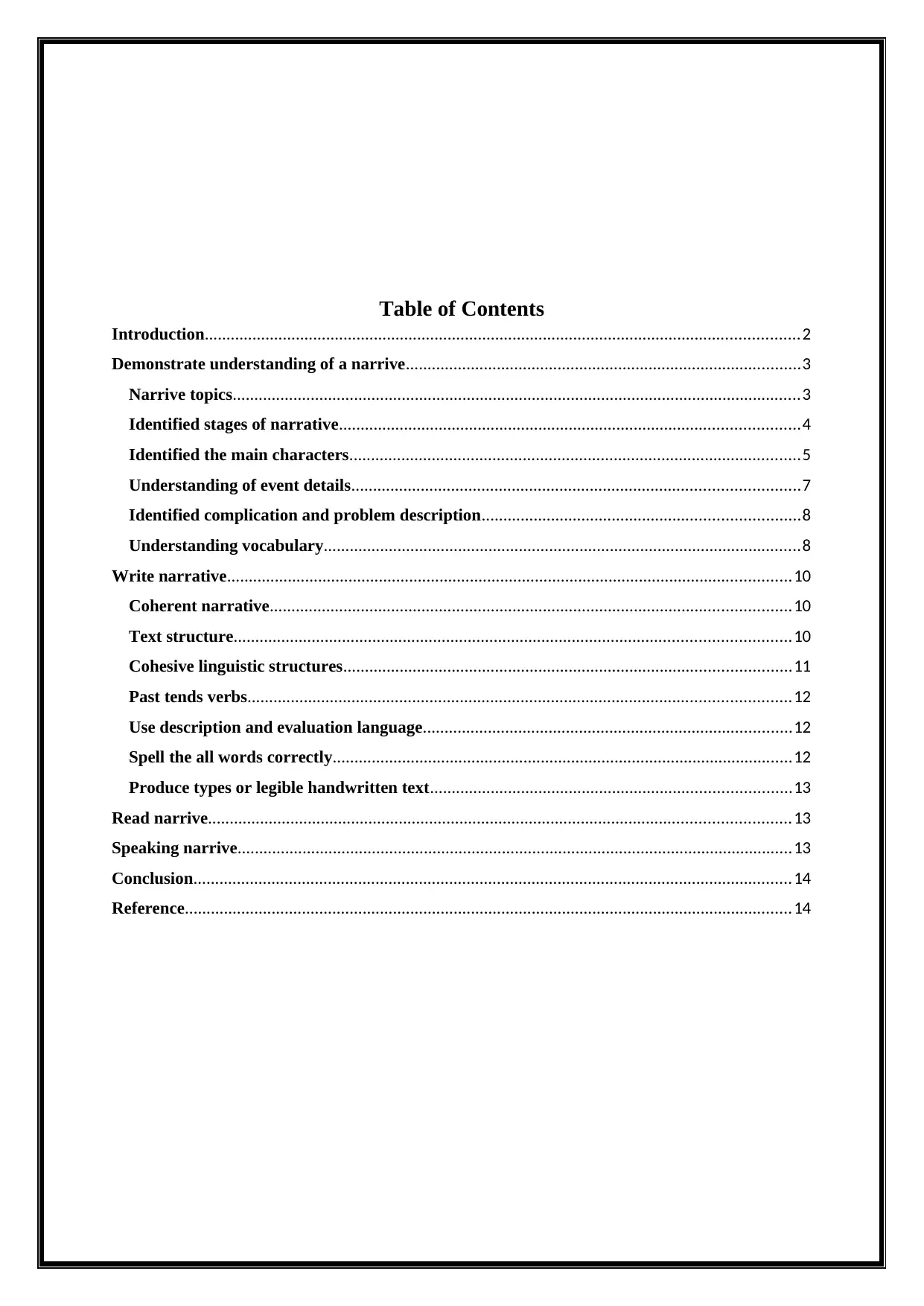
Table of Contents
Introduction.........................................................................................................................................2
Demonstrate understanding of a narrive...........................................................................................3
Narrive topics...................................................................................................................................3
Identified stages of narrative..........................................................................................................4
Identified the main characters........................................................................................................5
Understanding of event details.......................................................................................................7
Identified complication and problem description.........................................................................8
Understanding vocabulary..............................................................................................................8
Write narrative..................................................................................................................................10
Coherent narrative........................................................................................................................10
Text structure................................................................................................................................10
Cohesive linguistic structures.......................................................................................................11
Past tends verbs.............................................................................................................................12
Use description and evaluation language.....................................................................................12
Spell the all words correctly..........................................................................................................12
Produce types or legible handwritten text...................................................................................13
Read narrive......................................................................................................................................13
Speaking narrive................................................................................................................................13
Conclusion..........................................................................................................................................14
Reference............................................................................................................................................14
Introduction.........................................................................................................................................2
Demonstrate understanding of a narrive...........................................................................................3
Narrive topics...................................................................................................................................3
Identified stages of narrative..........................................................................................................4
Identified the main characters........................................................................................................5
Understanding of event details.......................................................................................................7
Identified complication and problem description.........................................................................8
Understanding vocabulary..............................................................................................................8
Write narrative..................................................................................................................................10
Coherent narrative........................................................................................................................10
Text structure................................................................................................................................10
Cohesive linguistic structures.......................................................................................................11
Past tends verbs.............................................................................................................................12
Use description and evaluation language.....................................................................................12
Spell the all words correctly..........................................................................................................12
Produce types or legible handwritten text...................................................................................13
Read narrive......................................................................................................................................13
Speaking narrive................................................................................................................................13
Conclusion..........................................................................................................................................14
Reference............................................................................................................................................14
⊘ This is a preview!⊘
Do you want full access?
Subscribe today to unlock all pages.

Trusted by 1+ million students worldwide
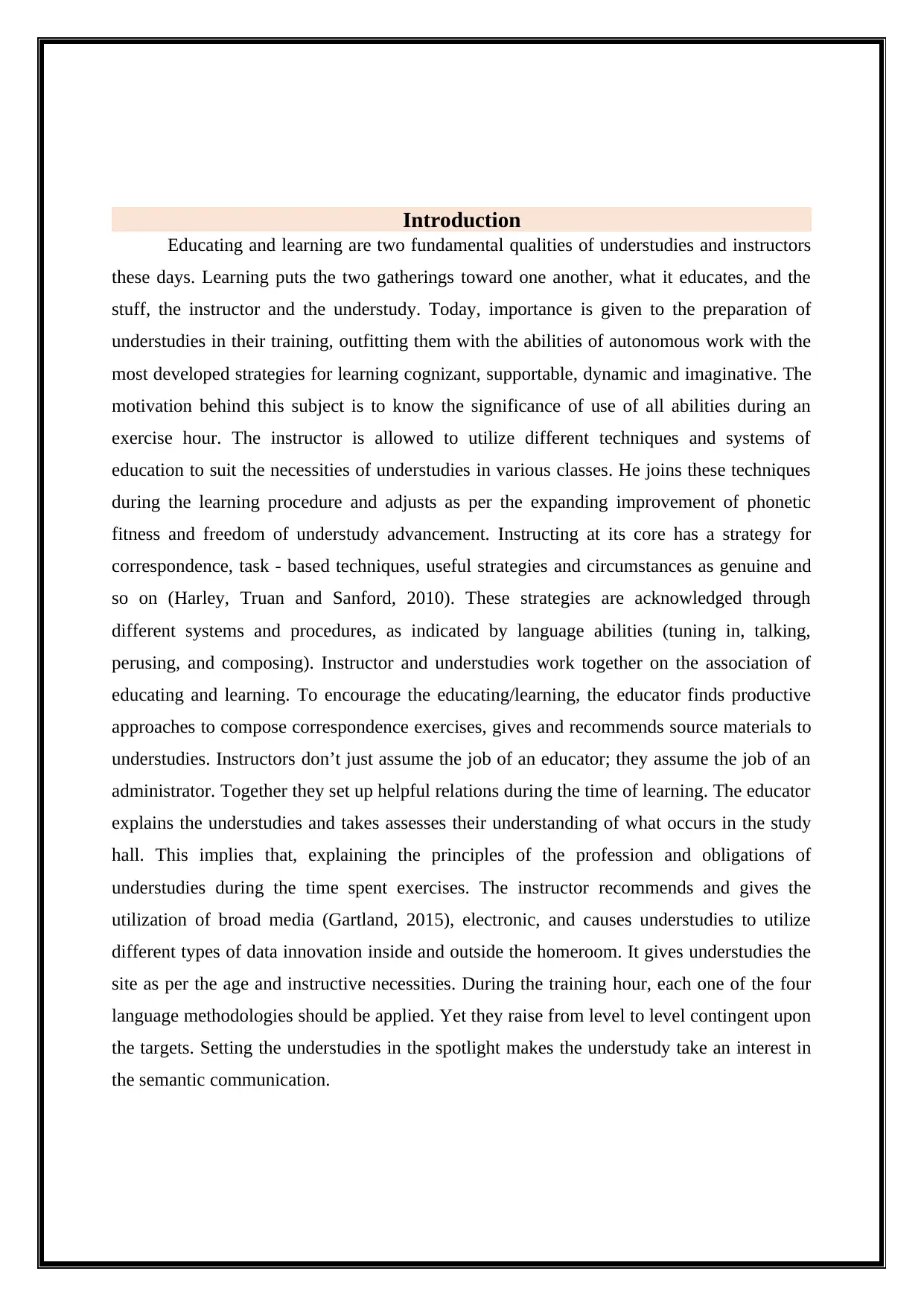
Introduction
Educating and learning are two fundamental qualities of understudies and instructors
these days. Learning puts the two gatherings toward one another, what it educates, and the
stuff, the instructor and the understudy. Today, importance is given to the preparation of
understudies in their training, outfitting them with the abilities of autonomous work with the
most developed strategies for learning cognizant, supportable, dynamic and imaginative. The
motivation behind this subject is to know the significance of use of all abilities during an
exercise hour. The instructor is allowed to utilize different techniques and systems of
education to suit the necessities of understudies in various classes. He joins these techniques
during the learning procedure and adjusts as per the expanding improvement of phonetic
fitness and freedom of understudy advancement. Instructing at its core has a strategy for
correspondence, task - based techniques, useful strategies and circumstances as genuine and
so on (Harley, Truan and Sanford, 2010). These strategies are acknowledged through
different systems and procedures, as indicated by language abilities (tuning in, talking,
perusing, and composing). Instructor and understudies work together on the association of
educating and learning. To encourage the educating/learning, the educator finds productive
approaches to compose correspondence exercises, gives and recommends source materials to
understudies. Instructors don’t just assume the job of an educator; they assume the job of an
administrator. Together they set up helpful relations during the time of learning. The educator
explains the understudies and takes assesses their understanding of what occurs in the study
hall. This implies that, explaining the principles of the profession and obligations of
understudies during the time spent exercises. The instructor recommends and gives the
utilization of broad media (Gartland, 2015), electronic, and causes understudies to utilize
different types of data innovation inside and outside the homeroom. It gives understudies the
site as per the age and instructive necessities. During the training hour, each one of the four
language methodologies should be applied. Yet they raise from level to level contingent upon
the targets. Setting the understudies in the spotlight makes the understudy take an interest in
the semantic communication.
Educating and learning are two fundamental qualities of understudies and instructors
these days. Learning puts the two gatherings toward one another, what it educates, and the
stuff, the instructor and the understudy. Today, importance is given to the preparation of
understudies in their training, outfitting them with the abilities of autonomous work with the
most developed strategies for learning cognizant, supportable, dynamic and imaginative. The
motivation behind this subject is to know the significance of use of all abilities during an
exercise hour. The instructor is allowed to utilize different techniques and systems of
education to suit the necessities of understudies in various classes. He joins these techniques
during the learning procedure and adjusts as per the expanding improvement of phonetic
fitness and freedom of understudy advancement. Instructing at its core has a strategy for
correspondence, task - based techniques, useful strategies and circumstances as genuine and
so on (Harley, Truan and Sanford, 2010). These strategies are acknowledged through
different systems and procedures, as indicated by language abilities (tuning in, talking,
perusing, and composing). Instructor and understudies work together on the association of
educating and learning. To encourage the educating/learning, the educator finds productive
approaches to compose correspondence exercises, gives and recommends source materials to
understudies. Instructors don’t just assume the job of an educator; they assume the job of an
administrator. Together they set up helpful relations during the time of learning. The educator
explains the understudies and takes assesses their understanding of what occurs in the study
hall. This implies that, explaining the principles of the profession and obligations of
understudies during the time spent exercises. The instructor recommends and gives the
utilization of broad media (Gartland, 2015), electronic, and causes understudies to utilize
different types of data innovation inside and outside the homeroom. It gives understudies the
site as per the age and instructive necessities. During the training hour, each one of the four
language methodologies should be applied. Yet they raise from level to level contingent upon
the targets. Setting the understudies in the spotlight makes the understudy take an interest in
the semantic communication.
Paraphrase This Document
Need a fresh take? Get an instant paraphrase of this document with our AI Paraphraser
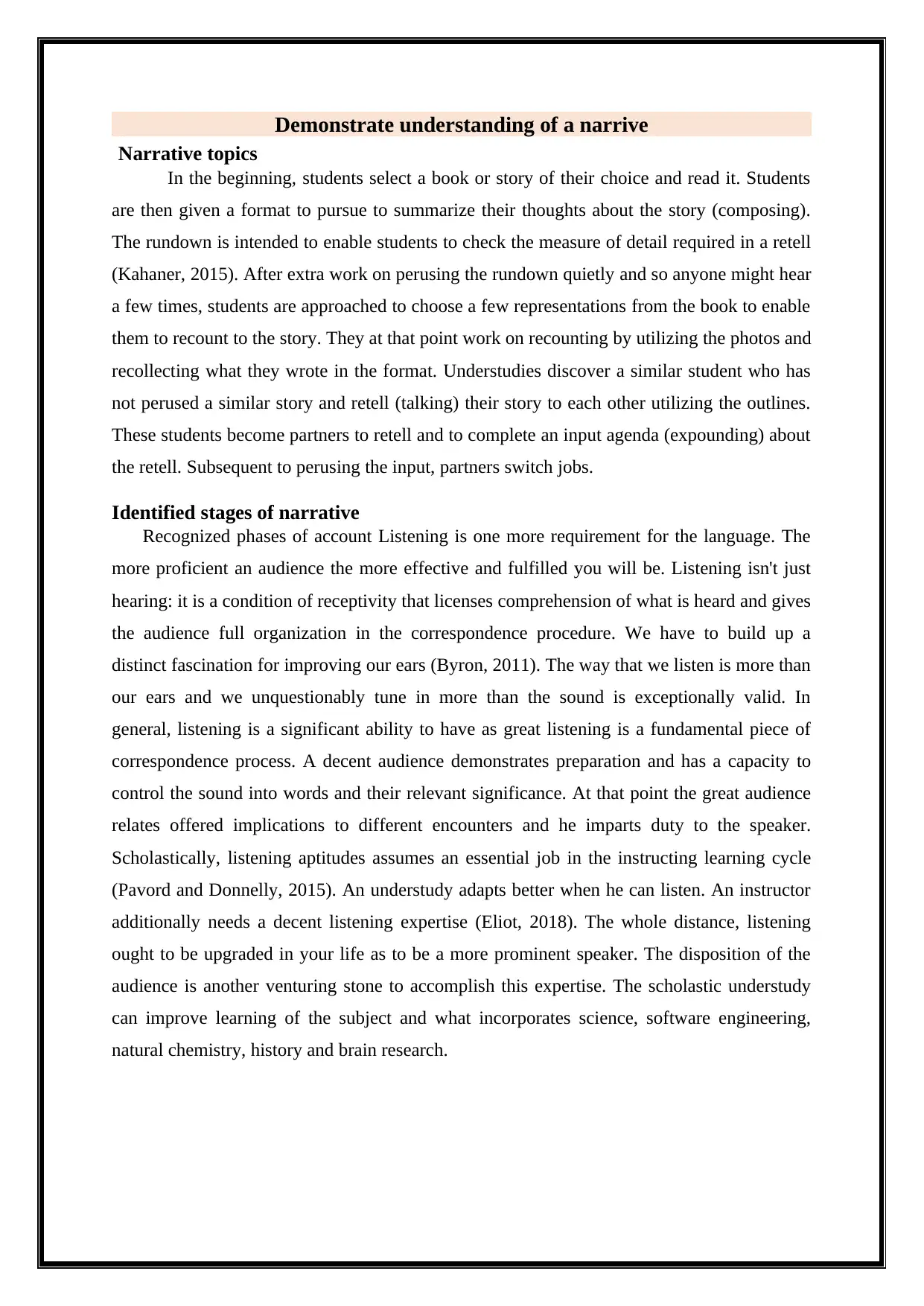
Demonstrate understanding of a narrive
Narrative topics
In the beginning, students select a book or story of their choice and read it. Students
are then given a format to pursue to summarize their thoughts about the story (composing).
The rundown is intended to enable students to check the measure of detail required in a retell
(Kahaner, 2015). After extra work on perusing the rundown quietly and so anyone might hear
a few times, students are approached to choose a few representations from the book to enable
them to recount to the story. They at that point work on recounting by utilizing the photos and
recollecting what they wrote in the format. Understudies discover a similar student who has
not perused a similar story and retell (talking) their story to each other utilizing the outlines.
These students become partners to retell and to complete an input agenda (expounding) about
the retell. Subsequent to perusing the input, partners switch jobs.
Identified stages of narrative
Recognized phases of account Listening is one more requirement for the language. The
more proficient an audience the more effective and fulfilled you will be. Listening isn't just
hearing: it is a condition of receptivity that licenses comprehension of what is heard and gives
the audience full organization in the correspondence procedure. We have to build up a
distinct fascination for improving our ears (Byron, 2011). The way that we listen is more than
our ears and we unquestionably tune in more than the sound is exceptionally valid. In
general, listening is a significant ability to have as great listening is a fundamental piece of
correspondence process. A decent audience demonstrates preparation and has a capacity to
control the sound into words and their relevant significance. At that point the great audience
relates offered implications to different encounters and he imparts duty to the speaker.
Scholastically, listening aptitudes assumes an essential job in the instructing learning cycle
(Pavord and Donnelly, 2015). An understudy adapts better when he can listen. An instructor
additionally needs a decent listening expertise (Eliot, 2018). The whole distance, listening
ought to be upgraded in your life as to be a more prominent speaker. The disposition of the
audience is another venturing stone to accomplish this expertise. The scholastic understudy
can improve learning of the subject and what incorporates science, software engineering,
natural chemistry, history and brain research.
Narrative topics
In the beginning, students select a book or story of their choice and read it. Students
are then given a format to pursue to summarize their thoughts about the story (composing).
The rundown is intended to enable students to check the measure of detail required in a retell
(Kahaner, 2015). After extra work on perusing the rundown quietly and so anyone might hear
a few times, students are approached to choose a few representations from the book to enable
them to recount to the story. They at that point work on recounting by utilizing the photos and
recollecting what they wrote in the format. Understudies discover a similar student who has
not perused a similar story and retell (talking) their story to each other utilizing the outlines.
These students become partners to retell and to complete an input agenda (expounding) about
the retell. Subsequent to perusing the input, partners switch jobs.
Identified stages of narrative
Recognized phases of account Listening is one more requirement for the language. The
more proficient an audience the more effective and fulfilled you will be. Listening isn't just
hearing: it is a condition of receptivity that licenses comprehension of what is heard and gives
the audience full organization in the correspondence procedure. We have to build up a
distinct fascination for improving our ears (Byron, 2011). The way that we listen is more than
our ears and we unquestionably tune in more than the sound is exceptionally valid. In
general, listening is a significant ability to have as great listening is a fundamental piece of
correspondence process. A decent audience demonstrates preparation and has a capacity to
control the sound into words and their relevant significance. At that point the great audience
relates offered implications to different encounters and he imparts duty to the speaker.
Scholastically, listening aptitudes assumes an essential job in the instructing learning cycle
(Pavord and Donnelly, 2015). An understudy adapts better when he can listen. An instructor
additionally needs a decent listening expertise (Eliot, 2018). The whole distance, listening
ought to be upgraded in your life as to be a more prominent speaker. The disposition of the
audience is another venturing stone to accomplish this expertise. The scholastic understudy
can improve learning of the subject and what incorporates science, software engineering,
natural chemistry, history and brain research.
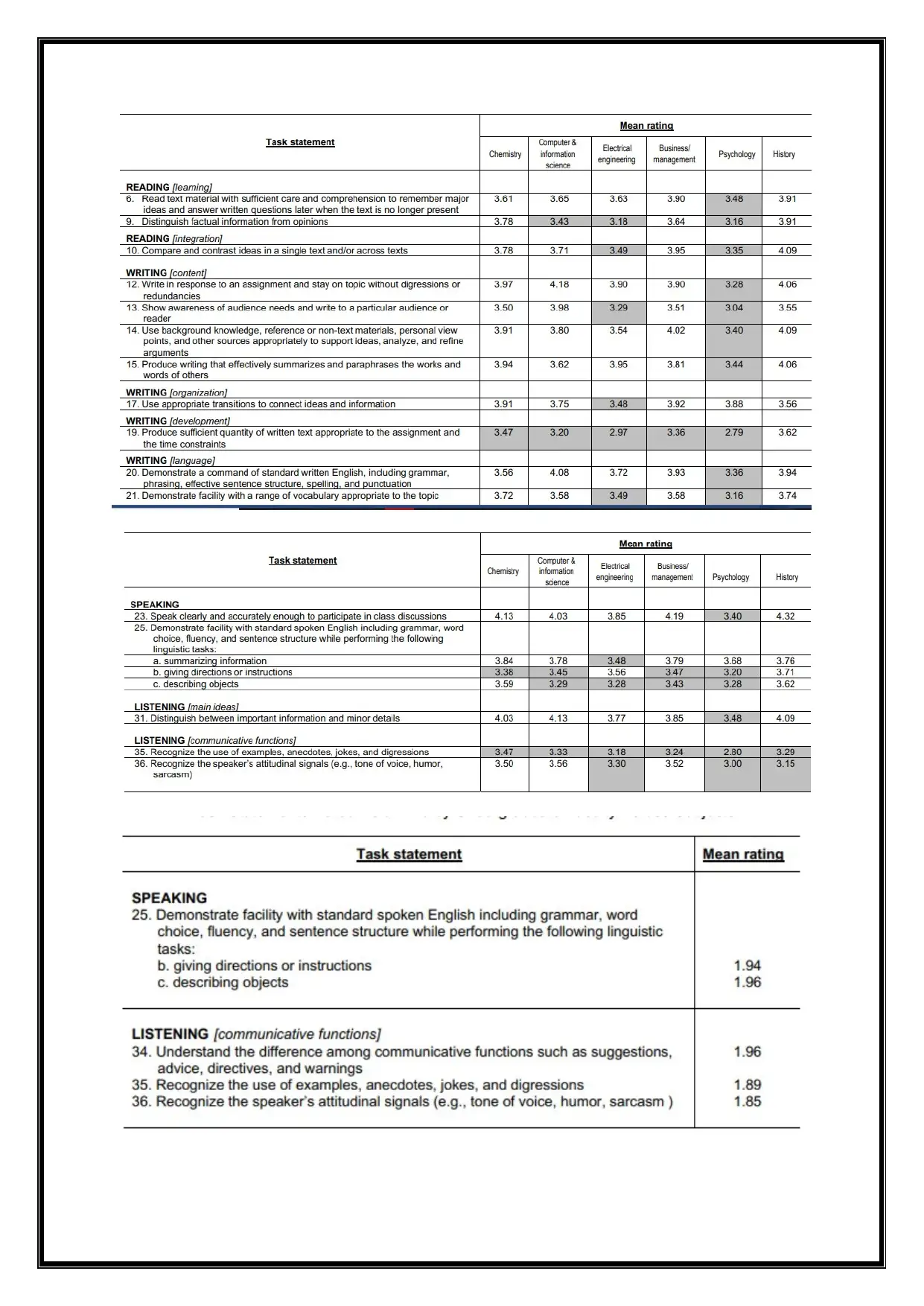
⊘ This is a preview!⊘
Do you want full access?
Subscribe today to unlock all pages.

Trusted by 1+ million students worldwide
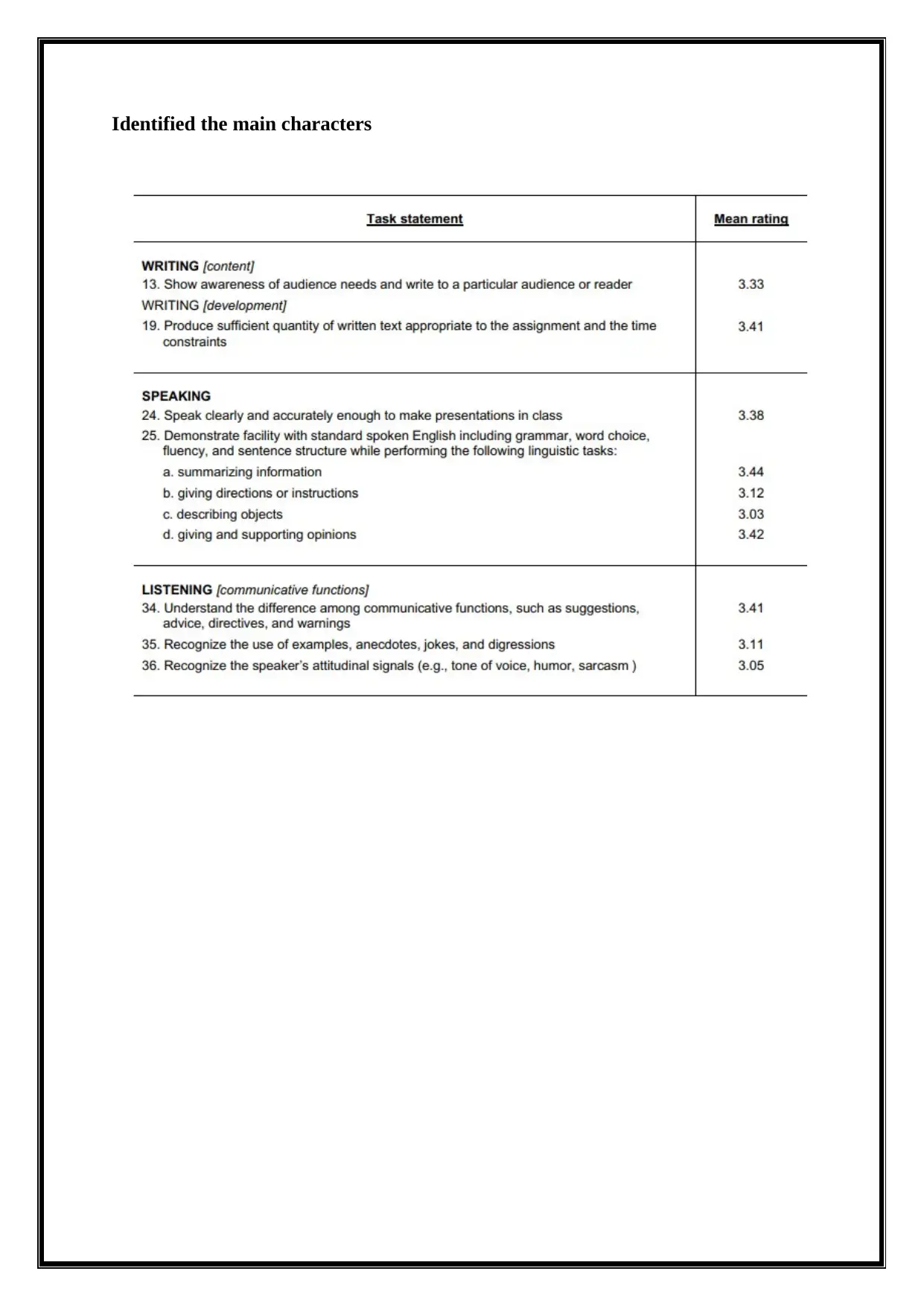
Identified the main characters
Paraphrase This Document
Need a fresh take? Get an instant paraphrase of this document with our AI Paraphraser
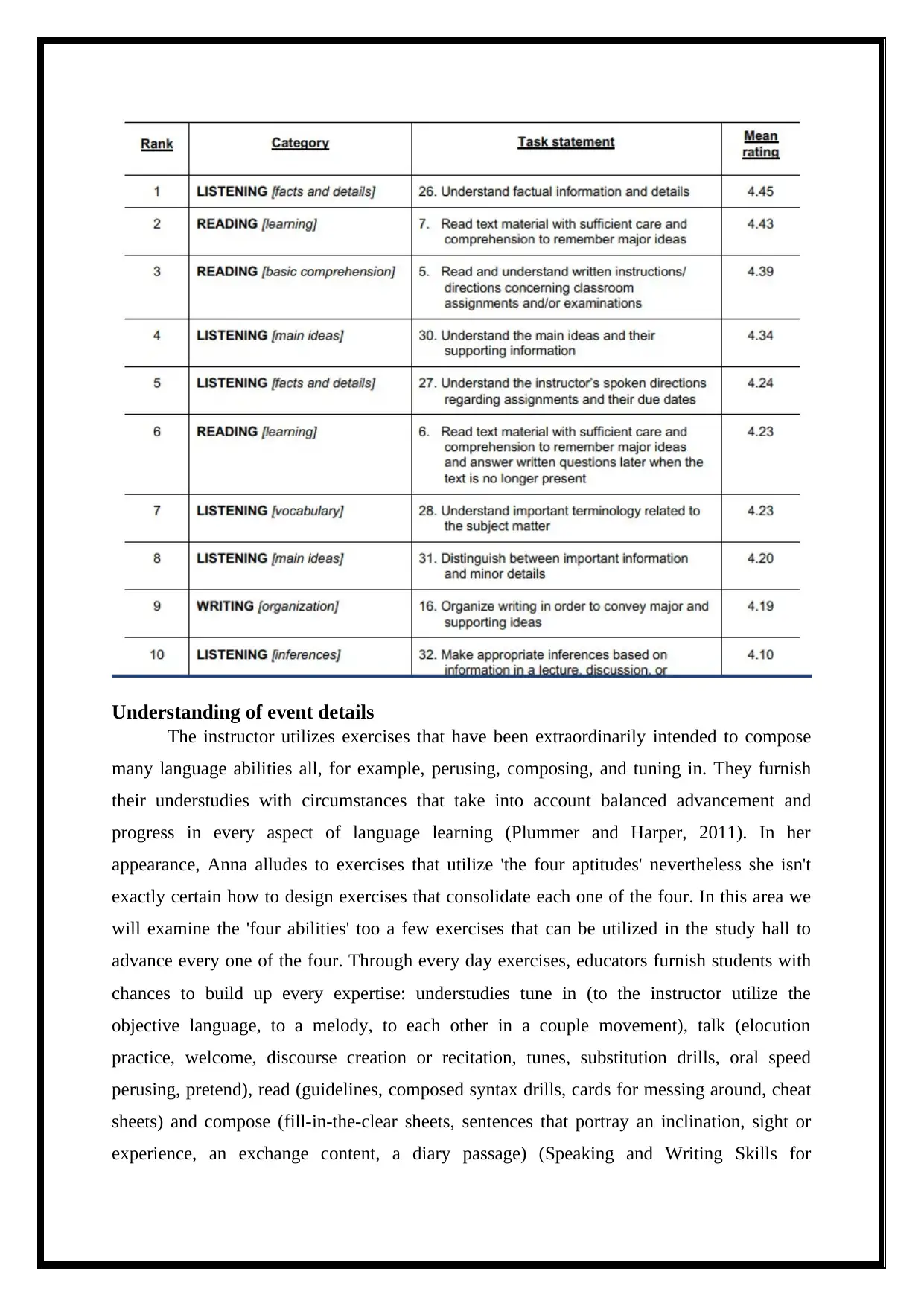
Understanding of event details
The instructor utilizes exercises that have been extraordinarily intended to compose
many language abilities all, for example, perusing, composing, and tuning in. They furnish
their understudies with circumstances that take into account balanced advancement and
progress in every aspect of language learning (Plummer and Harper, 2011). In her
appearance, Anna alludes to exercises that utilize 'the four aptitudes' nevertheless she isn't
exactly certain how to design exercises that consolidate each one of the four. In this area we
will examine the 'four abilities' too a few exercises that can be utilized in the study hall to
advance every one of the four. Through every day exercises, educators furnish students with
chances to build up every expertise: understudies tune in (to the instructor utilize the
objective language, to a melody, to each other in a couple movement), talk (elocution
practice, welcome, discourse creation or recitation, tunes, substitution drills, oral speed
perusing, pretend), read (guidelines, composed syntax drills, cards for messing around, cheat
sheets) and compose (fill-in-the-clear sheets, sentences that portray an inclination, sight or
experience, an exchange content, a diary passage) (Speaking and Writing Skills for
The instructor utilizes exercises that have been extraordinarily intended to compose
many language abilities all, for example, perusing, composing, and tuning in. They furnish
their understudies with circumstances that take into account balanced advancement and
progress in every aspect of language learning (Plummer and Harper, 2011). In her
appearance, Anna alludes to exercises that utilize 'the four aptitudes' nevertheless she isn't
exactly certain how to design exercises that consolidate each one of the four. In this area we
will examine the 'four abilities' too a few exercises that can be utilized in the study hall to
advance every one of the four. Through every day exercises, educators furnish students with
chances to build up every expertise: understudies tune in (to the instructor utilize the
objective language, to a melody, to each other in a couple movement), talk (elocution
practice, welcome, discourse creation or recitation, tunes, substitution drills, oral speed
perusing, pretend), read (guidelines, composed syntax drills, cards for messing around, cheat
sheets) and compose (fill-in-the-clear sheets, sentences that portray an inclination, sight or
experience, an exchange content, a diary passage) (Speaking and Writing Skills for
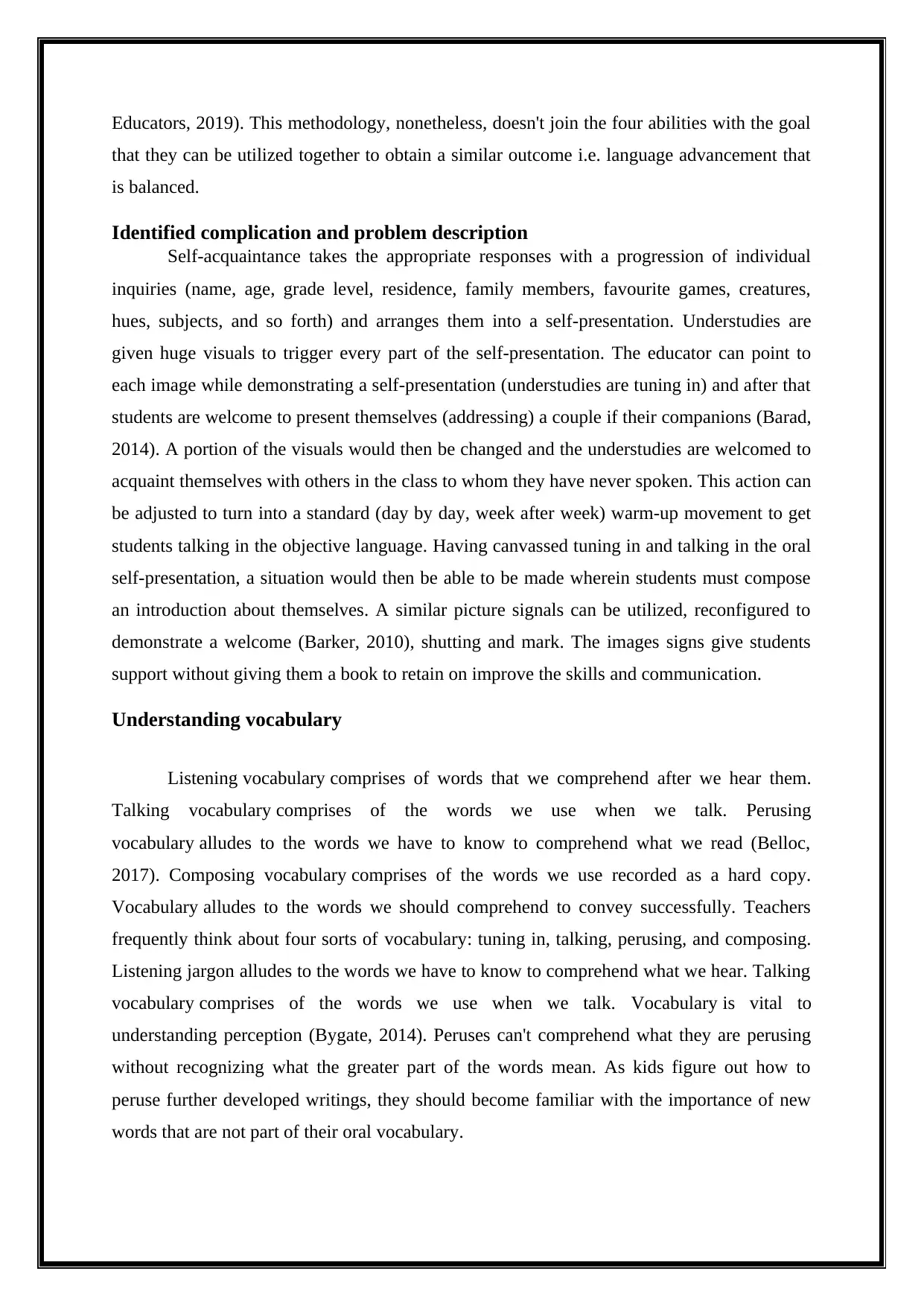
Educators, 2019). This methodology, nonetheless, doesn't join the four abilities with the goal
that they can be utilized together to obtain a similar outcome i.e. language advancement that
is balanced.
Identified complication and problem description
Self-acquaintance takes the appropriate responses with a progression of individual
inquiries (name, age, grade level, residence, family members, favourite games, creatures,
hues, subjects, and so forth) and arranges them into a self-presentation. Understudies are
given huge visuals to trigger every part of the self-presentation. The educator can point to
each image while demonstrating a self-presentation (understudies are tuning in) and after that
students are welcome to present themselves (addressing) a couple if their companions (Barad,
2014). A portion of the visuals would then be changed and the understudies are welcomed to
acquaint themselves with others in the class to whom they have never spoken. This action can
be adjusted to turn into a standard (day by day, week after week) warm-up movement to get
students talking in the objective language. Having canvassed tuning in and talking in the oral
self-presentation, a situation would then be able to be made wherein students must compose
an introduction about themselves. A similar picture signals can be utilized, reconfigured to
demonstrate a welcome (Barker, 2010), shutting and mark. The images signs give students
support without giving them a book to retain on improve the skills and communication.
Understanding vocabulary
Listening vocabulary comprises of words that we comprehend after we hear them.
Talking vocabulary comprises of the words we use when we talk. Perusing
vocabulary alludes to the words we have to know to comprehend what we read (Belloc,
2017). Composing vocabulary comprises of the words we use recorded as a hard copy.
Vocabulary alludes to the words we should comprehend to convey successfully. Teachers
frequently think about four sorts of vocabulary: tuning in, talking, perusing, and composing.
Listening jargon alludes to the words we have to know to comprehend what we hear. Talking
vocabulary comprises of the words we use when we talk. Vocabulary is vital to
understanding perception (Bygate, 2014). Peruses can't comprehend what they are perusing
without recognizing what the greater part of the words mean. As kids figure out how to
peruse further developed writings, they should become familiar with the importance of new
words that are not part of their oral vocabulary.
that they can be utilized together to obtain a similar outcome i.e. language advancement that
is balanced.
Identified complication and problem description
Self-acquaintance takes the appropriate responses with a progression of individual
inquiries (name, age, grade level, residence, family members, favourite games, creatures,
hues, subjects, and so forth) and arranges them into a self-presentation. Understudies are
given huge visuals to trigger every part of the self-presentation. The educator can point to
each image while demonstrating a self-presentation (understudies are tuning in) and after that
students are welcome to present themselves (addressing) a couple if their companions (Barad,
2014). A portion of the visuals would then be changed and the understudies are welcomed to
acquaint themselves with others in the class to whom they have never spoken. This action can
be adjusted to turn into a standard (day by day, week after week) warm-up movement to get
students talking in the objective language. Having canvassed tuning in and talking in the oral
self-presentation, a situation would then be able to be made wherein students must compose
an introduction about themselves. A similar picture signals can be utilized, reconfigured to
demonstrate a welcome (Barker, 2010), shutting and mark. The images signs give students
support without giving them a book to retain on improve the skills and communication.
Understanding vocabulary
Listening vocabulary comprises of words that we comprehend after we hear them.
Talking vocabulary comprises of the words we use when we talk. Perusing
vocabulary alludes to the words we have to know to comprehend what we read (Belloc,
2017). Composing vocabulary comprises of the words we use recorded as a hard copy.
Vocabulary alludes to the words we should comprehend to convey successfully. Teachers
frequently think about four sorts of vocabulary: tuning in, talking, perusing, and composing.
Listening jargon alludes to the words we have to know to comprehend what we hear. Talking
vocabulary comprises of the words we use when we talk. Vocabulary is vital to
understanding perception (Bygate, 2014). Peruses can't comprehend what they are perusing
without recognizing what the greater part of the words mean. As kids figure out how to
peruse further developed writings, they should become familiar with the importance of new
words that are not part of their oral vocabulary.
⊘ This is a preview!⊘
Do you want full access?
Subscribe today to unlock all pages.

Trusted by 1+ million students worldwide
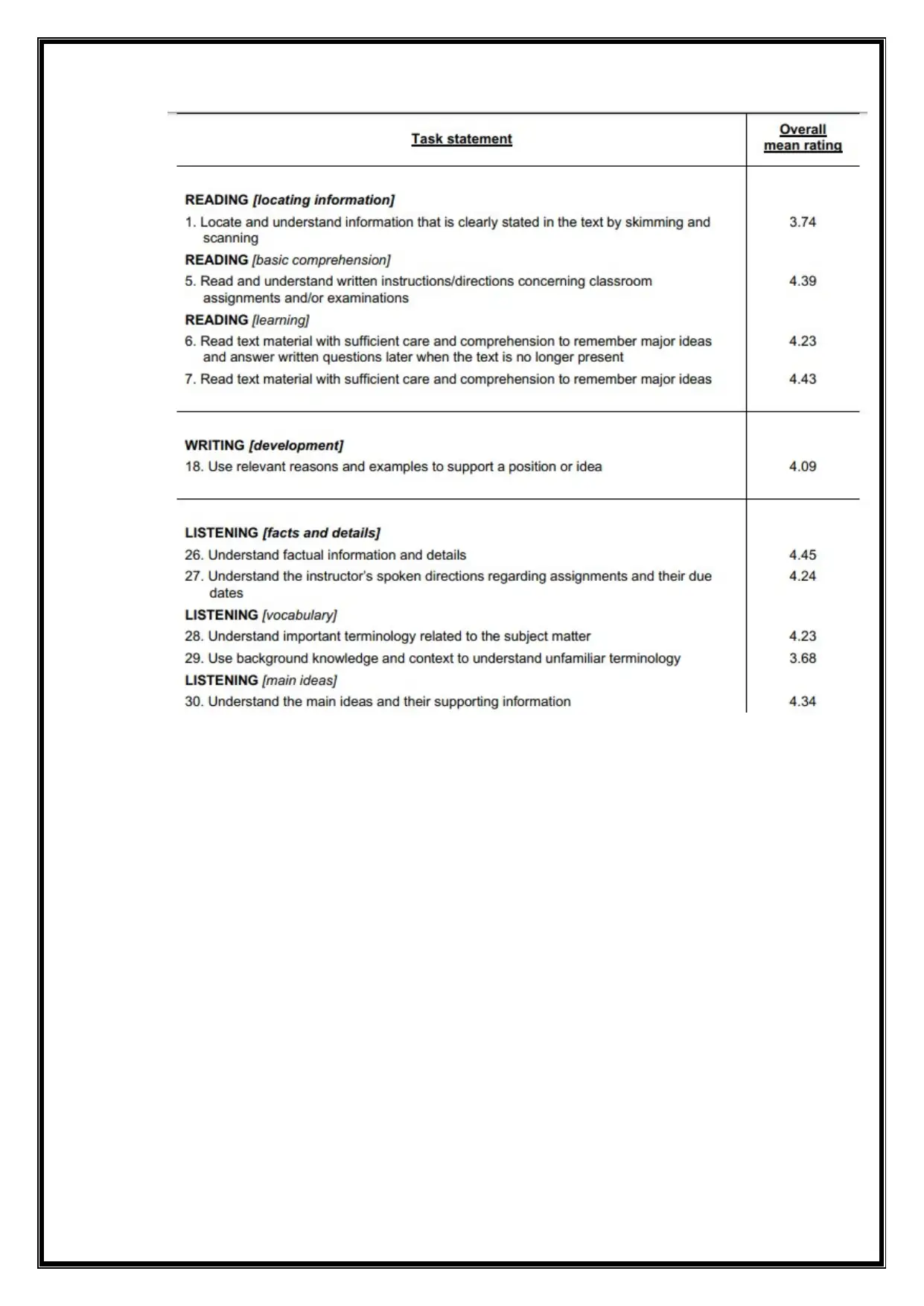
Paraphrase This Document
Need a fresh take? Get an instant paraphrase of this document with our AI Paraphraser
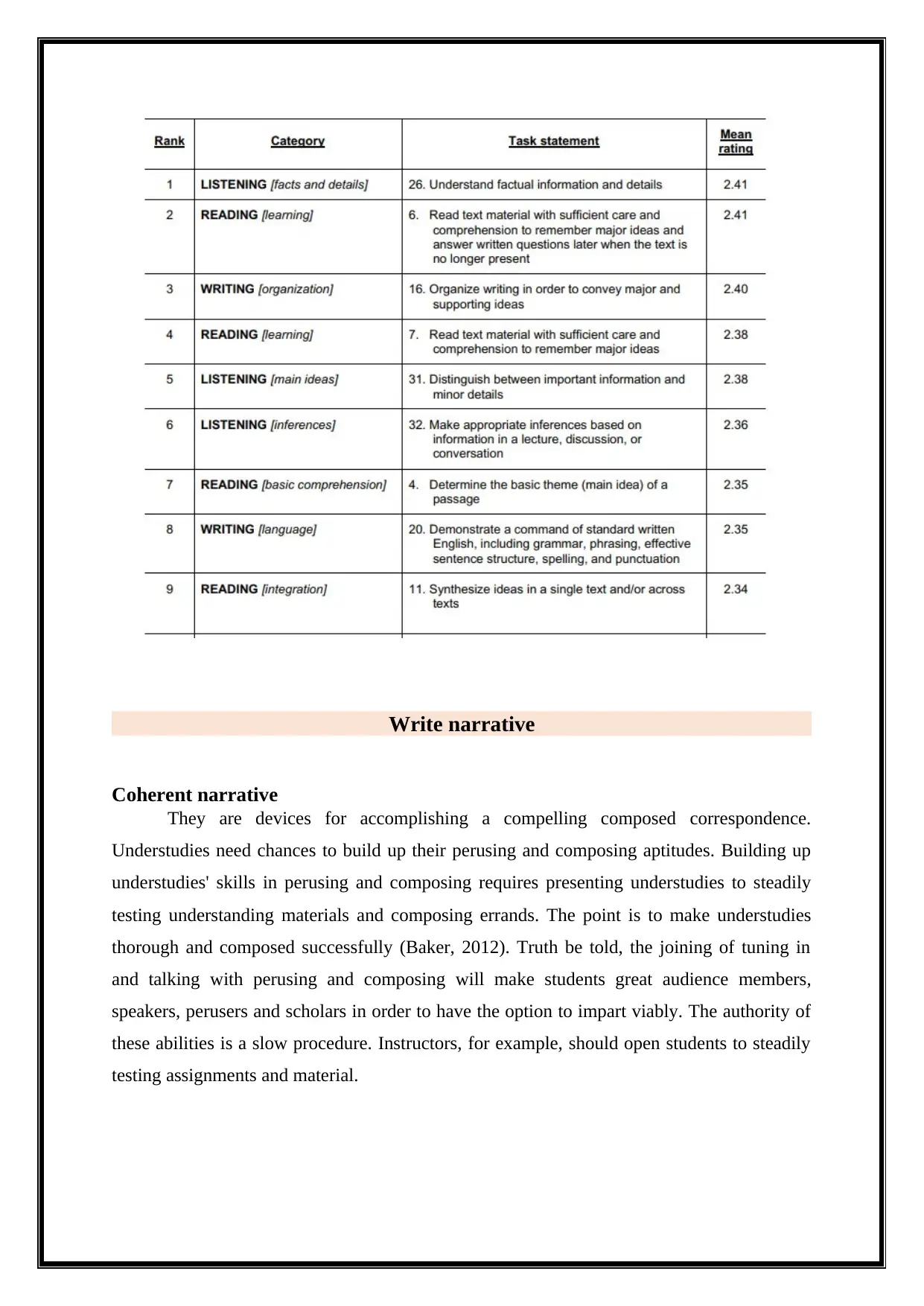
Write narrative
Coherent narrative
They are devices for accomplishing a compelling composed correspondence.
Understudies need chances to build up their perusing and composing aptitudes. Building up
understudies' skills in perusing and composing requires presenting understudies to steadily
testing understanding materials and composing errands. The point is to make understudies
thorough and composed successfully (Baker, 2012). Truth be told, the joining of tuning in
and talking with perusing and composing will make students great audience members,
speakers, perusers and scholars in order to have the option to impart viably. The authority of
these abilities is a slow procedure. Instructors, for example, should open students to steadily
testing assignments and material.
Coherent narrative
They are devices for accomplishing a compelling composed correspondence.
Understudies need chances to build up their perusing and composing aptitudes. Building up
understudies' skills in perusing and composing requires presenting understudies to steadily
testing understanding materials and composing errands. The point is to make understudies
thorough and composed successfully (Baker, 2012). Truth be told, the joining of tuning in
and talking with perusing and composing will make students great audience members,
speakers, perusers and scholars in order to have the option to impart viably. The authority of
these abilities is a slow procedure. Instructors, for example, should open students to steadily
testing assignments and material.
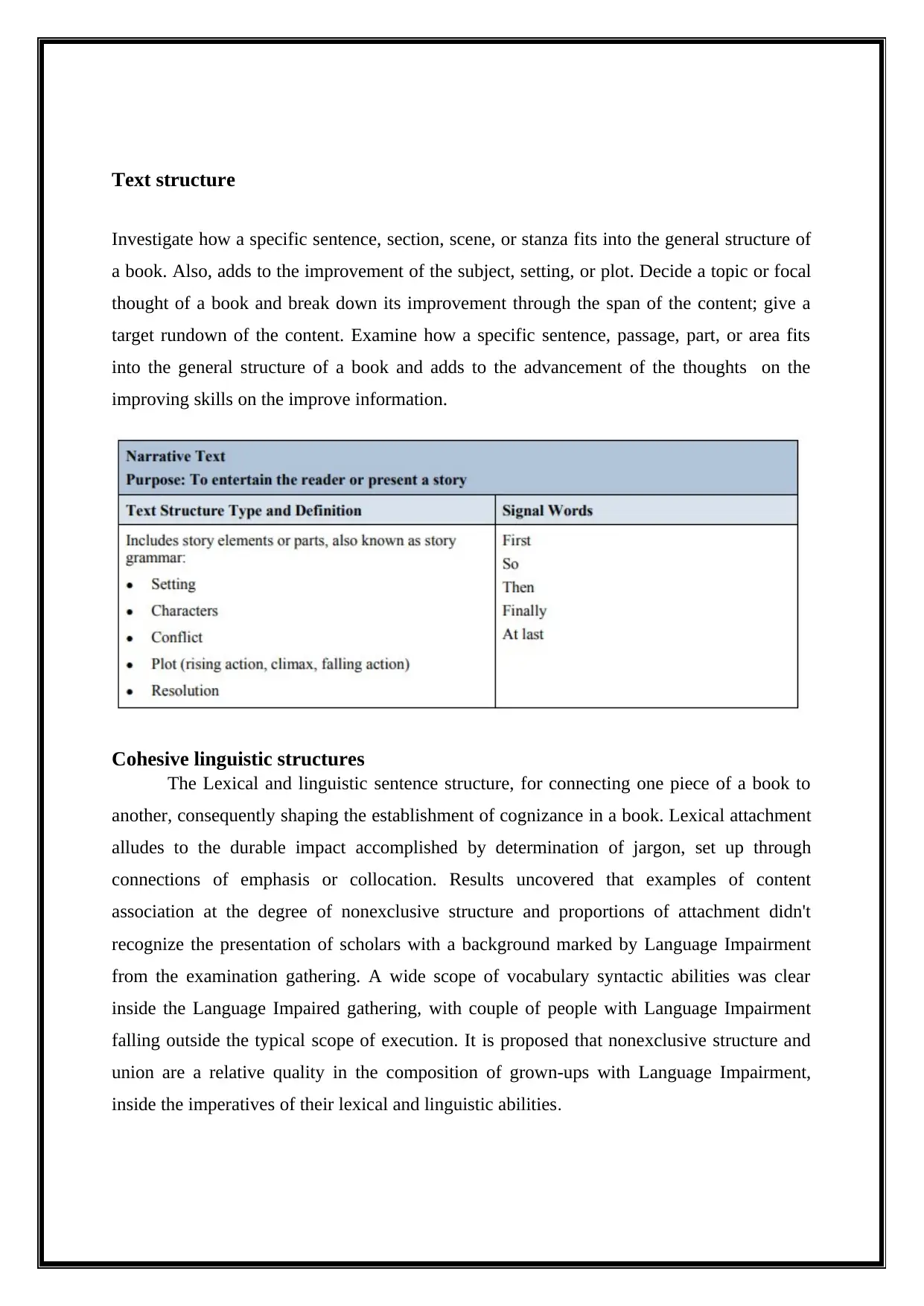
Text structure
Investigate how a specific sentence, section, scene, or stanza fits into the general structure of
a book. Also, adds to the improvement of the subject, setting, or plot. Decide a topic or focal
thought of a book and break down its improvement through the span of the content; give a
target rundown of the content. Examine how a specific sentence, passage, part, or area fits
into the general structure of a book and adds to the advancement of the thoughts on the
improving skills on the improve information.
Cohesive linguistic structures
The Lexical and linguistic sentence structure, for connecting one piece of a book to
another, consequently shaping the establishment of cognizance in a book. Lexical attachment
alludes to the durable impact accomplished by determination of jargon, set up through
connections of emphasis or collocation. Results uncovered that examples of content
association at the degree of nonexclusive structure and proportions of attachment didn't
recognize the presentation of scholars with a background marked by Language Impairment
from the examination gathering. A wide scope of vocabulary syntactic abilities was clear
inside the Language Impaired gathering, with couple of people with Language Impairment
falling outside the typical scope of execution. It is proposed that nonexclusive structure and
union are a relative quality in the composition of grown-ups with Language Impairment,
inside the imperatives of their lexical and linguistic abilities.
Investigate how a specific sentence, section, scene, or stanza fits into the general structure of
a book. Also, adds to the improvement of the subject, setting, or plot. Decide a topic or focal
thought of a book and break down its improvement through the span of the content; give a
target rundown of the content. Examine how a specific sentence, passage, part, or area fits
into the general structure of a book and adds to the advancement of the thoughts on the
improving skills on the improve information.
Cohesive linguistic structures
The Lexical and linguistic sentence structure, for connecting one piece of a book to
another, consequently shaping the establishment of cognizance in a book. Lexical attachment
alludes to the durable impact accomplished by determination of jargon, set up through
connections of emphasis or collocation. Results uncovered that examples of content
association at the degree of nonexclusive structure and proportions of attachment didn't
recognize the presentation of scholars with a background marked by Language Impairment
from the examination gathering. A wide scope of vocabulary syntactic abilities was clear
inside the Language Impaired gathering, with couple of people with Language Impairment
falling outside the typical scope of execution. It is proposed that nonexclusive structure and
union are a relative quality in the composition of grown-ups with Language Impairment,
inside the imperatives of their lexical and linguistic abilities.
⊘ This is a preview!⊘
Do you want full access?
Subscribe today to unlock all pages.

Trusted by 1+ million students worldwide
1 out of 16
Your All-in-One AI-Powered Toolkit for Academic Success.
+13062052269
info@desklib.com
Available 24*7 on WhatsApp / Email
![[object Object]](/_next/static/media/star-bottom.7253800d.svg)
Unlock your academic potential
Copyright © 2020–2025 A2Z Services. All Rights Reserved. Developed and managed by ZUCOL.